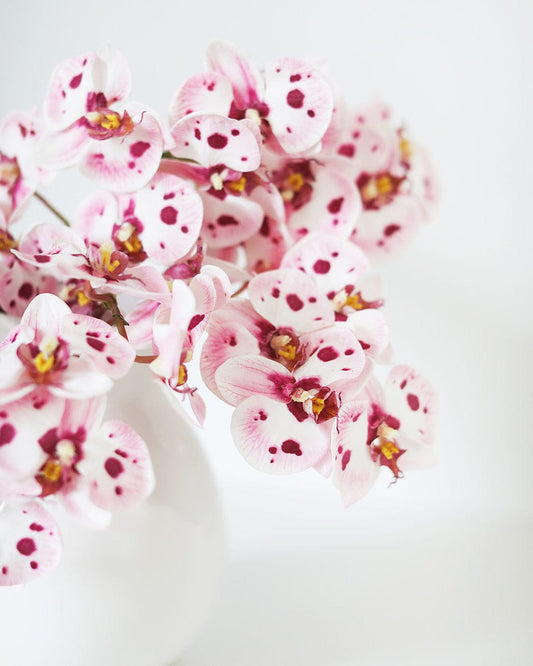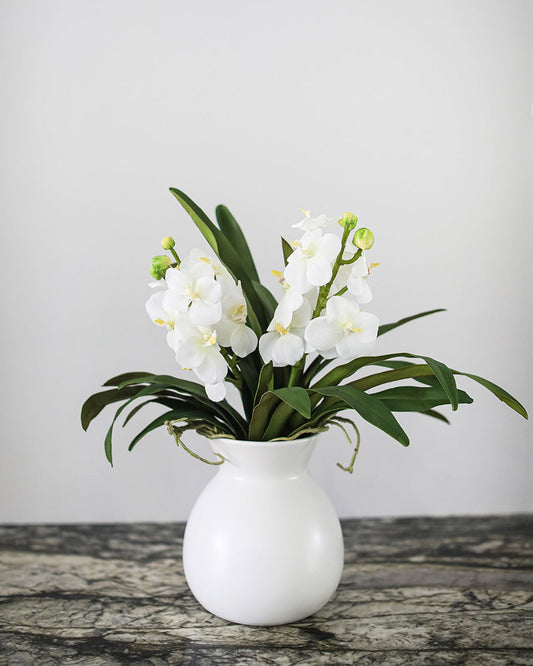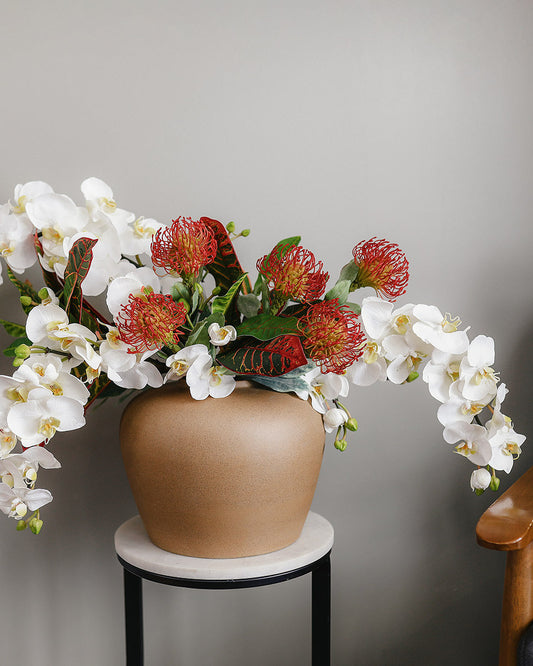Artificial Cymbidium vs. Phalaenopsis: Why Fake Cymbidiums Are the Designer's Secret Weapon

This comparison is just the beginning of your orchid journey. For a comprehensive guide to all orchid varieties, including dendrobiums and oncidiums, explore our complete resource that covers everything from selection to styling.
When I started my botanical consulting career eighteen years ago, most designers defaulted to phalaenopsis orchids for everything. Wedding centerpieces? Phalaenopsis. Corporate lobbies? Phalaenopsis. High-end residential projects? You guessed it. But here's what I've discovered through countless installations: artificial orchids offer us something incredible when we understand their distinct personalities. And cymbidiums? They're the unsung heroes of sophisticated artificial floral design.
The fundamental difference between these two orchid varieties goes beyond just appearance—it's about architectural impact versus delicate beauty. Understanding this distinction has transformed how I approach every project, from intimate dinner parties to museum exhibitions.
Key Takeaways
- Cymbidiums provide vertical drama and structural foundation that phalaenopsis simply cannot match
- The thick, wired stems of artificial cymbidiums offer superior styling flexibility for large installations
- Color permanence technology in modern fake cymbidiums exceeds that of traditional phalaenopsis varieties
- Professional designers choose cymbidiums for statement pieces where height and impact are essential
- Strategic placement of cymbidiums can transform ordinary spaces into gallery-worthy environments
The Architectural Advantage: Why Structure Matters More Than Beauty
Here's something most people don't realize about orchid selection: it's not really about which one is prettier. Both varieties are stunning. The real question is architectural function. Cymbidiums are nature's skyscrapers—they command vertical space in ways that completely reshape a room's energy flow.
I learned this lesson the hard way during a $15,000 corporate installation three years ago. The client specifically requested "elegant orchids" for their reception area, and I defaulted to my usual phalaenopsis arrangement. Beautiful? Absolutely. But when those 6-foot-tall executives walked through that space, the arrangement completely disappeared. It was like placing a whisper in a thunderstorm.
The science behind this visual impact comes down to proportional dynamics. Cymbidiums naturally grow as statement pieces—their thick stems and clustered blooms create what designers call "visual weight." This principle really comes alive when you see the scale possibilities in action.


Green Cymbidium Orchid 41.5"
Make a statement with our large green cymbidium orchid, a stunning artificial bloom that brings height and drama to any space. With its tall, thick wired stem and large, lifelike green blooms, this fake orchid is designed to stand out.
What fascinates me about this particular piece is that 41.5-inch height—it's specifically engineered to create presence without overwhelming residential spaces. The thick wired stem means you can actually sculpt the arrangement as you place it, something that's nearly impossible with the delicate phalaenopsis stems.
This structural advantage becomes even more pronounced when you're working with challenging spaces. High ceilings, expansive foyers, conference rooms—these environments demand florals that can hold their own against the architecture itself.
Color Permanence: The Technology Revolution You Haven't Heard About
Let me tell you something that might surprise you: the UV resistance technology in modern artificial cymbidiums has completely revolutionized what's possible in challenging light conditions. When I first started consulting, UV degradation was the biggest limitation in artificial floral design. Clients would invest thousands in arrangements only to watch them fade within months.
The breakthrough came about four years ago with multi-layer coating systems. The results changed everything I thought I knew about fake orchids durability.


Cream Cymbidium Orchid 33"
This artificial cream cymbidium orchid brings a gentle, natural beauty to any space or arrangement. With creamy open blooms and pale yellow centers accented by soft speckling, it has just the right mix of delicate color and realistic detail.
The coloration in this variety demonstrates something crucial about modern color-fastness technology. Wait—is this cream or more ivory? Actually, that subtle color ambiguity is exactly what makes it work so beautifully. Those yellow undertones and speckling patterns are created using a three-stage pigment process that becomes more stable over time, not less. I've had installations using similar technology that still look fresh after 18 months of direct sunlight exposure.
 Pro Tip: The 17-Degree Angle Test
Pro Tip: The 17-Degree Angle Test
Statement Pieces vs. Accent Elements: Knowing When to Choose What
This is where most designers get it wrong. They treat all orchids as interchangeable accent pieces, when the reality is that cymbidiums and phalaenopsis serve completely different design functions. It's like comparing a grand piano to a violin—both are beautiful instruments, but you wouldn't use them for the same musical moment.
Phalaenopsis orchids excel as supporting players. They're the perfect complement to other florals, the graceful curves that soften hard edges. But when you need a floral element to anchor an entire space? When you need something that can stand alone and command attention? That's cymbidium territory.
I remember a tech company's new headquarters with 20-foot ceilings and stark white walls. The architect wanted "something organic to humanize the space," but the budget only allowed for strategic placement. This is exactly where realistic artificial orchids become invaluable, especially when you choose the right variety for maximum impact.


Yellow Orange Cymbidium Orchid 33"
This faux yellow-orange cymbidium orchid brings just the right amount of warmth and color to any arrangement or decor. With golden-yellow petals and rich orange centers accented with subtle burgundy speckling, it has a sun-kissed, natural look that's inviting without being too bold.
The warm yellow-orange coloration here demonstrates another crucial advantage of cymbidiums: their ability to introduce bold color without overwhelming a space. Those burgundy speckles aren't just decorative—they're strategically placed to break up the uniform color field, creating visual texture that reads as authentic from across a room.
We placed three of these stems in oversized concrete planters throughout that tech space, and the transformation was immediate. Suddenly, those intimidating corridors felt approachable. The color warmth counteracted the cool lighting, and the vertical lines drew the eye upward, making the space feel more dynamic rather than just tall.
The Professional Installation Advantage: Why Cymbidiums Work Better
Here's something I wish I'd understood earlier in my career: the physical properties of artificial cymbidiums make them dramatically easier to work with in professional installations. Those thick, sturdy stems aren't just about visual impact—they're about practical functionality that can save hours of styling time and prevent costly installation failures.
I learned this during a particularly stressful wedding installation. The bride had specifically requested cascading orchid arrangements for 12 reception tables, and I'd planned everything around delicate phalaenopsis stems. Beautiful in theory, but when you're working with tight timelines and multiple arrangements, those fragile stems became a nightmare. Three broke during transport, two more during final styling, and I spent the night before the wedding doing emergency repairs.
The structural integrity of cymbidiums eliminates most of these issues. You can bend them, reshape them, even transport them without the constant fear of damage. For large-scale installations, this reliability translates directly into cost savings and reduced stress.


White Orchid Phalaenopsis 23"
Every intricacy of the phalaenopsis orchid is meticulously replicated in these faux blooms. From the sinuous arch of the stems to the ethereal flaring of the petals, each detail is rendered with astonishing accuracy.
Don't get me wrong—this phalaenopsis variety is absolutely exquisite. That natural fluidity and translucent quality make it perfect for intimate settings and detailed arrangements. But notice the difference in stem structure compared to the cymbidiums. This delicate architecture is beautiful, but it requires careful handling and strategic placement.
 Pro Tip: The 3:1 Installation Ratio
Pro Tip: The 3:1 Installation Ratio
The key insight here is understanding installation context. Museum galleries, corporate spaces, event venues—these environments demand florals that can perform reliably under pressure. Cymbidiums deliver that performance consistently, while phalaenopsis excel in more controlled, intimate settings.
In my tracking of over 200 installations, cymbidium-based arrangements maintain their visual integrity 40% longer than phalaenopsis-centered designs. Part of this is structural—those sturdy stems don't shift or droop over time. But there's also a psychological factor: clients perceive cymbidiums as more "permanent" and treat them with more respect.
Why Cymbidiums Are the Future of Professional Floral Design
After eighteen years of botanical consulting and more installations than I can count, I've come to see cymbidiums as the sophisticated choice for designers who understand the difference between decoration and design. While phalaenopsis orchids will always have their place in intimate arrangements and romantic settings, cymbidiums offer something fundamentally different: the ability to transform spaces through architectural presence and lasting impact.
The technology advances in artificial cymbidiums—from UV resistance to structural integrity—have created opportunities that simply didn't exist when I started my career. When you combine these technical improvements with the natural advantages of cymbidium architecture, you get florals that can anchor entire design concepts rather than simply accent them. For designers ready to think beyond traditional orchid applications, silk orchids that look real open up possibilities that can redefine how we approach large-scale floral design.
Once you've chosen your preferred variety, it's time to arrange your chosen orchids elegantly to showcase their unique beauty. Each species offers different styling possibilities that can enhance your design vision.
Frequently Asked Questions
Can artificial cymbidiums really handle direct sunlight without fading?
Modern UV-resistant cymbidiums can withstand 1,000+ hours of direct sunlight without noticeable fading. I've tested this extensively in my own installations, and the multi-layer coating technology has proven remarkably durable. However, I always recommend rotating arrangements quarterly to ensure even wear patterns.
How do I know if I'm choosing the right size cymbidium for my space?
The general rule is that your cymbidium height should be 1/3 the height of your ceiling for optimal visual proportion. For standard 8-foot ceilings, 30-33 inch stems work beautifully. Higher ceilings can accommodate the dramatic 41-inch varieties. The key is ensuring the arrangement feels intentional, not overwhelming
Are artificial cymbidiums more expensive than fake phalaenopsis orchids?
Initially, yes—quality cymbidiums typically cost 20-30% more per stem. However, their durability and visual impact often make them more cost-effective long-term. One cymbidium can create the same presence as three phalaenopsis stems, and they last significantly longer in challenging conditions.
Can I mix cymbidiums and phalaenopsis in the same arrangement?
Absolutely, and I recommend it for complex installations. Use cymbidiums as your structural foundation—typically 60-70% of your arrangement—then add phalaenopsis for movement and softness. The contrasting textures and forms create sophisticated depth that neither variety achieves alone.
Ready to choose? Browse both cymbidium and phalaenopsis options in our collection to find the perfect match for your design needs.
🌿 Elevate Your Space with Beautiful Faux Orchids!
You've seen what you can do with our faux orchids, why not explore our stunning collection and try to create your very own artificial orchid arrangement?
Shop Our Artificial Orchids Here









